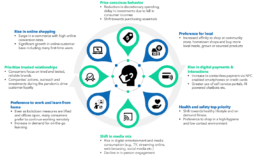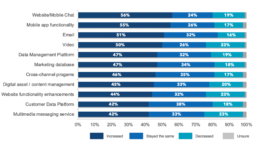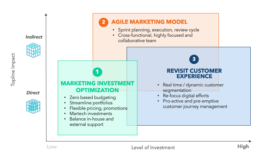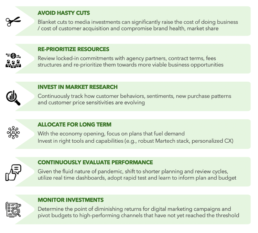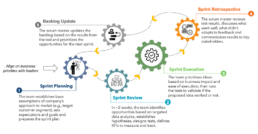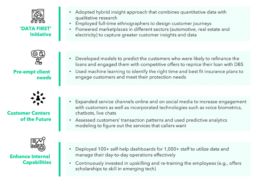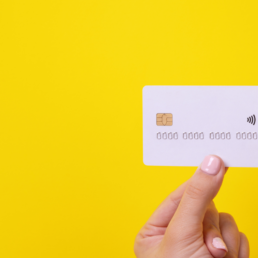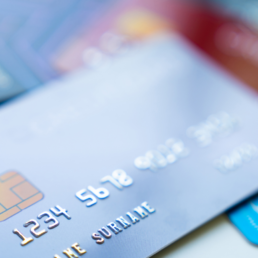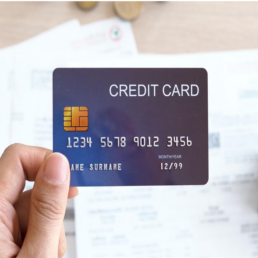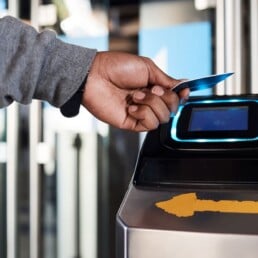“COVID-19 has changed the way we internet.” – The New York Times
Marketers are feeling the impact of the immense changes in almost every aspect of human life. Customers want to browse, shop, seek entertainment and learn online while sitting in the comfort of their homes. They are also more cognizant of the brands they buy from and deeply connect with the local community.
Marketers are not only forced to cut budgets to save costs, but they also face the challenge of keeping up with changing customer priorities and behaviors. History shows enough evidence that it’s critical for businesses to continue their marketing efforts during such a crisis to recover faster and gain market share. Customers may not be buying, but they are engaging heavily across digital channels (e.g., social media).
In this paper we share a three-pronged approach marketers can adopt to successfully navigate the current transformed landscape. We discuss the need for surgical cost cutting and re-allocation of investments, fundamental changes in the way marketing organizations work, and precision targeting across customer journeys.
ACCELERATING CHANGES IN CUSTOMER BEHAVIOR
‘The future is here, but it’s not evenly distributed’ – William Gibson
The pandemic has driven rapid and lasting changes in customer behavior. Customers now want to own their experiences and greatly rely on digital interactions. They want to explore new avenues to interact with brands, consume content, and transact at fingertips or by voice, from anywhere (see Exhibit 1 below).
Exhibit 1: Emerging Customer Behaviors
While some changes in behavior (e.g., digital interactions) were already in motion before the pandemic, they now have become essential to survive and thrive in the post pandemic era. Marketers who are able to apply microscopic lens to customer needs, nimbly adjust their strategies, and reallocate investments accordingly stand to realize both immediate and long-term gains.
THE IMPACT TO MARKETING HAS BEGUN
The first few months of the pandemic have already had a significant impact:
1. Budget cuts
Marketing budgets started strong at the beginning of 2020. However, the pandemic has since resulted in mid-year budget cuts for more than 44% of CMOs, of which 11% expect their budgets to further face significant cuts of more than 15%1. As a result, some 41% of CMOs delayed campaign launches and 37% reduced headcount1.
2. Martech investments survive the cut
Despite uncertain times, Martech investments accounted for 26% of marketing budgets in 20201. In fact, 68% of CMOs expect an increase in their investments in Martechs including mobile marketing, data platforms, digital commerce, over the next 12 months.
Exhibit 2 below shows that majority of the marketers have increased investments in technology to enhance customer engagement and expand outreach during the pandemic.
Exhibit 2: Spend on Marketing Technologies During the Pandemic
3. Digital dominates spend mix
In 2020, investments in paid, owned, and earned digital channels accounted for ~80% of total multichannel budget, with digital advertising (14%), SEO (10%), social marketing (11%), website (10%) topping the list. Since customers have rapidly increased use of online platforms for information, purchases, entertainment etc., marketers have followed. Heading into 2021, CMOs expect digital advertising budgets to rise and plan to increase investments in webinars, organic social, paid social while reduce investments in out of home and in-person experiences.
4. Shift to virtual/hybrid events
To prevent event cancellations and minimize revenue losses during the pandemic, marketers shifted live events to virtual platforms. Conducting virtual/hybrid events not only helped marketers save costs but also provided other benefits such as greater audience reach and better data acquisition.
5. Increased social media usage
During the first two months of the pandemic, enterprise spending on social media grew 74%3, a sizeable increase in a short span of time. Marketers expect it to stay at about the same level in the next year. The increase in spending is in response to the high usage of social media platforms by the customers, during the pandemic. In an effort to boost customer engagement and brand sentiment, marketers are using social media to post brand content, organize community engagement events, host Twitter chats via influencers as well as develop hashtags to encourage people to participate and re-post.
MARKETING MATTERS, EVEN IN A DOWNTURN
Past recessions have shown that firms who continue marketing efforts and maintain moderate levels of media continuity recover faster post recession as well as outperform competition.
At this stage, we recommend marketers rapidly pivot to take full advantage of emerging opportunities through a three-pronged approach (exhibit 3):
Exhibit 3: A winning approach to marketing
RE-ALIGN INVESTMENTS
The economic downturn and rapid customer behavior changes present an opportunity for marketers to surgically cut costs and re-align investments. Exhibit 4 outlines a few guiding principles.
Exhibit 4: Guiding principles for investment optimization
Return of zero based budgeting
Given the fundamental shift in marketing needs, zero based budgeting is most appropriate for re-aligning investments from the old to the new opportunities. In our experience, firms can save 20-30% through zero-based budgeting. Other benefits include:
- Holistic and granular view of the budget
- Clear cost accountability
- Surfacing hidden costs since budgets are tied to specific activities and levels of service
- Distinguishing between high and low value investments
- Achieving closer alignment with customer and channel priorities
Streamline product portfolios
Expansive product portfolios are difficult to sustain as they absorb marketing and R&D costs, add complexity for customers and sales reps in the buying process and distract resources from innovation. Marketers should assess the relevancy and long term viability of the portfolio by utilizing external data (e.g., customer needs, behaviors, market dynamics, competition) along with internal data to identify the margins, growth rates and true costs associated with keeping a product line alive as well as identify opportunities for retirement (products with low growth potential, overlapping use cases, high costs to sustain etc.).
Offer flexible pricing and promotions
The economic downturn has amplified customer price sensitivities and forced businesses to increasingly compete on price. During this time, marketers should increase the frequency of temporary price promotions or quantity reliefs (e.g., reduce threshold for quantity discounts). It is important to note that excessive promotions during tough times can drive price expectations lower affecting future profitability of the firm during recovery.
In order to cater to near term pricing needs while maintaining flexibility for future, marketers can unbundle offerings, offer flexible payment options, run limited-time promotions etc. Incentives / special pricing packages can be offered to dependable, loyal customers to strengthen relationships and lower incentives of switching to a competitor. To continuously optimize pricing and promotions in a dynamic landscape, marketers must invest in customer price sensitivity research and run frequent market tests.
Revisit agency partnerships
Many agencies have experienced a significant fall in overall revenue and lead generation due to the pandemic. Because of the new and difficult situation, they are also open to a greater degree of flexibility in client relationships. Over 50%4 of agencies are offering flexibility in contract terms and 28%4 actually reduced fees.
Given the ever-expanding landscape of creative, media, analytics, social with limited resources, it may be worthwhile to review / re-negotiate existing agency relationships (contract terms, fees, services offered) to:
a. Smoothly navigate the changed marketing landscape (optimize media planning, revamp content strategy, invest in programmatic advertising etc.)
b. Fill in-house resource skill gaps with third party/external support
Bolster marketing technology roadmap
A robust Martech stack helps marketers easily connect with customers at every stage of the marketing funnel and helps them navigate the customer journey. It collects customer data, builds buyer personas, delivers messages and executes campaigns across platforms. Unfortunately, marketers are often forced to stitch together their own tech stack by purchasing several point solutions that deliver a sub-par customer experience and reduce speed to market.
To thrive in recovery period, marketers must spend time to craft Martech strategy – assess the gaps between current and future state, build a roadmap that eliminates tech redundancies, streamline vendors and enable moment-based marketing for customers.
ACCELERATE ADOPTION OF AGILE
The pandemic is also accelerating the agile journey of marketing functions. Agility enables businesses to be adaptive, creative and highly responsive, all of which are critical capabilities needed to recover revenue losses during the pandemic.
Agile, in the marketing context, means conducting rapid iterations of campaigns, not aiming for perfection, executing multiple small experiments over a large one, working in collaboration over silos, responding to changes rather than following a plan, so that marketers can achieve greater speed, shorter time to market and higher customer responsiveness. Exhibit 5 below shows how an agile marketing process can work.
This process is iterative, short projects are deployed with quick measurement, and adjustments are made based on customer feedback and market conditions. To make agile marketing processes work, highly networked, cross-functional teams that focus on a customer segment/persona/’moment’ in the customer journey are required. These teams are able to collaborate quickly and work autonomously to complete, test and launch projects. Traditionally, marketing has been organized by skill-set silos (e.g., creative, web, social media, PR etc.) which leads to a number of problems such as lack of accountability, conflicting priorities, delayed projects, and poor execution. Cross-functional teams eliminate most of these problems, as they improve communication and coordination, keep a laser focus on customer experience, and efficiently utilize skillsets to deliver minimum viable products (MVPs).
Agile teams often called ‘squads’, ‘pods’ or ‘tribes’ have well defined goals and objectives tied to the target customer segment / journey as well as aligned to overall business priorities. They have clear deliverables and metrics that they track their performance against (e.g., increase open rates, click through rates, expand campaign outreach, boost conversion etc.). A scrum master oversees the teams, updates the back log, sets priorities and manages sprint workshop (planning, execution, review, retrospective).
Exhibit 5: The agile marketing process
A couple of additional considerations ensure high effectiveness of this model:
Bolster data, analytics and tech infrastructure
Invest in capturing, managing, unifying customer data across disparate systems to build robust propensity, next best action models, automate campaign delivery across channels and create a customer feedback loop.
Integrate agencies within the pod / squad
Incorporate external agencies into the agile process right from the planning stage to provide full context and transparency. Ensure clear division of tasks between internal vs. external resources. Marketers usually prefer to keep core skills such as strategy development in-house and hire agencies to fill resource gaps or conduct execution.
The transition to agile for most marketers is not easy. It is a fundamental change in approach from focusing on product or brand to focusing on the customer. Marketers will need to adopt a start-up like mindset – one that is customer centric, resilient, focuses on speedy continuous improvements and prioritizes execution over research.
REVISIT CUSTOMER EXPERIENCE
The impact of the pandemic on customer behavior has been unprecedented and likely permanent. The following tools and capabilities will be critical in the recovery period:
Real time / Dynamic Customer Segmentation
The first step is to understand the new customer segments that have emerged during the crisis. Many marketers still use static segments that are updated on a very slow schedule and don’t keep up with changing customer needs. By adopting dynamic customer segmentation, marketers can instill thoughtfully designed moments of truth experiences across the customer journey.
Dynamic customer segmentation uses real-time consumer data to create fluid segments, consisting of individuals with certain propensities to take a specific action. By ingesting new data from customer interactions, these segments grow and shrink, as customers move in and out of the segments, automatically triggering the right campaigns at the right time.
For example, the moment a new buyer completes a purchase, they are automatically added to the ‘new customer segment’ and sent a welcome email. Once the dynamic segments are set up, firms can run multiple targeted campaigns to boost loyalty, drive new purchases, win back at-risk customers enabling a new level of contextual relevancy in customer interactions.
This segmentation style is both dynamic and predictive. Not only does the customer’s segment assignment change as their behavior changes, but their propensities also update in real time increasing the marketer’s ability to respond rapidly to emerging trends and make timely predictions.
A pre-requisite for adopting this model is ensuring a unified view of customer data in place, so that all customer interactions across website/mobile and other channels can be tracked accurately. Marketers today struggle with integrating the data as it is captured and stored across disparate systems. Data cleansing, data enrichment and making the data actionable will be foundational in getting the most out of this model.
Re-focusing digital efforts based on evolving customer needs
The pandemic has exponentially increased adoption of SoLoMo (Social, Local, Mobile). Use of mobile banking apps, for example, reached 72%5 of customers at the four largest U.S. banks in April 2020. Contactless payments grew significantly, with Mastercard reporting over 40%6 growth in contactless transactions globally during the first quarter of 2020. Given the rapid surge in digital interactions, Forrester forecasts that the division between Field and Inside sales roles will finally slip away, with 80% or more of the sales cycle happening in digital/remote settings. It is highly likely that consumers will prefer and continue to use digital offerings even after the crisis.
COVID-19 has emerged as the catalyst that finally moves digital past the tipping point. Businesses that were already online or able to pivot online quickly, were able to deal with the disruption much better.
Within financial services, previously risk averse firms are now showing greater agility while digitally mature financial institutions are reaping benefits of their past investments. Some examples include:
During the pandemic, Wells Fargo added a number of new digital capabilities to expand the toolbox of ‘Wells Fargo Online’ in less than a month. The new features included online requests for mortgage payment deferrals, digital applications for the small business Paycheck Protection Program, expanded support for customers to deposit stimulus payments, and higher limits for mobile deposits.7
Similarly, DBS Singapore quickly offered ‘contact free’ banking to its clients. It digitalized 11 common trade financing processes to reduce reliance on physical OTC exchanges and offered clients 50 free FAST transactions a month to cut the need for physical cheque handling.8 The bank also partnered with ComfortDelGro (transportation company) so that users could book and pay seamlessly through an integrated in-app booking function on DBS PayLah!9
Further, as part of the banks’ relief efforts, a free COVID-19 hospital cash insurance policy was provided, which recorded more than 52,000 sign-ups a day at its peak.
Another example was set by the Chinese giant Ping An who introduced ‘Do it At Home’ campaign to offer contactless and smart services. It focused on strategic upgrade in terms of channel, service, capability of its online healthcare platform ‘Good Doctor’, registering a surge in total number of users to 346M10 in June 2020. Users of Ping An Pocket Bank app (for retail customers) exceeded 100M10, an 11.8%10 increase from the beginning of 2020. Bank’s AI powered customer service offered 24*7 consultation services to customers when call centers were closed. Applications for loans were fully managed online, shortening loan approval process to just 10 seconds.
Pro-active and pre-emptive customer journey management
As digital offerings become the norm, marketers must find unique ways to truly differentiate themselves in the market. A key step towards this is to adopt a more data-rich approach to serve unanticipated needs of customers and create experiences that are personalised and better than the in-person experience.
Due to the increased online traffic, marketers have the opportunity to capture as much real-time information about customers, as well as obtain customers’ consent to receive marketing messages long term.
(e.g. join loyalty program). They can then anticipate and predict customer sentiment and customer value through AI models. This will enable marketers to develop proactive engagement strategies, targeted solutions and add in “wow” moments throughout customer journey.
To further take it to the next level, marketers can collaborate with technology teams to explore emerging technologies such as 5G, IoT, blockchain and quantum computing. This can help improve business outcomes and enhance the customer journey.
For example, DBS bank uses customer science to manage customer journeys. It connects customer behaviour with application and system data to understand the impact of behaviour on systems and vice versa. This aids in predicting and preventing problems before they occur, helping DBS understand customer demands through journey management, application health monitoring and workforce management.12 The bank incorporates metrics like customer profitability, customer satisfaction, campaign optimization, workforce automation, pre-emptive issue resolution, real-time insights to assess performance. Over the last 5 years, it has made the shift to an agile and continuous integration and continuous delivery (CI/CD) model13, enabling it to roll out releases 10 times faster than before and help navigate the crisis.
Exhibit 6: DBS taps data analytics to optimize customer journeys
Exhibit 6 above summarizes few initiatives the bank has undertaken to optimize customer journeys.
The bank now plans to focus on 5G infrastructure to make it easier to work from home and extend services (e.g., mobile ATMs in more locations amid a pandemic or emergency) as well as explore IoT and video analytics to monitor crowds at ATMs and branches.
IN CLOSING…
The COVID-19 pandemic has re-shaped the landscape for marketers. While marketers have had to cancel events, delay product launches and cut budgets, they have also witnessed a significant surge in the use of SoLoMo.
The unprecedented changes in customer behaviour and diminished resources call for a broader shift in marketing tactics and investments. Zero based strategizing can help develop a clear view of what customers value. Fundamental shift towards agile marketing practices can enable faster recovery as well as build better customer responsiveness.
A new level of contextual relevancy can be added to customer interactions by shifting to a more dynamic customer segmentation. Marketers who can take this a step further by predicting and fulfilling client needs will be able to truly differentiate and win in the market.
Sources/Notes:
- Gartner CMO Spend Survey, 2020
- Merkle Marketing Spend Survey, March – June 2020
- The CMO Survey, May 2020
- The Impact of COVID-19 on Digital Agencies; Survey conducted by Uplers
- “Digital Banking is surging during the pandemic. Will it last?” American Banker, April 2020
- Wall Street Journal, April 2020
- Wells Fargo Company press release
- ”Coronavirus-dbs-pushes-contact-free-digital-banking” Finextra, 2020
- DBS Company press release
- “Ping-an-healthcare-and-technology-company-limited-announces-2020-interim-report”, PRNewswire, 2020.
- ”Ping-an-bank-named-asias-best-digital-bank-by-euromoney-a-first-for-chinese-bank”, PRNewswire, 2020.
- “How DBS Bank is riding the digital innovation wave, CIO.com, April 2020.
- ”How-DBS-is-reaping-dividends-of-digital-transformation”, ComputerWeekly, April 2020.
- “DBS Bank invests in analytics to get to know its customers”, diginomica; ”How DBS made data its culture”, content.io; Company press releases
